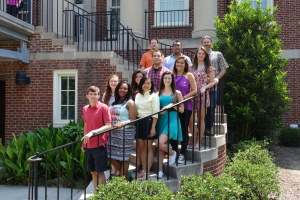Math-Biology REU
2015 Projects
 Summer 2015 Participants
Summer 2015 Participants
- Florida Southern College
- Gonzaga University
- Grinnell College
- Mercer University
- Northern Kentucky University
- Texas Christian University
- University of North Carolina at Greensboro
- Winthrop University
- Worcester Polytechnic Institute
Territorial Raider Games
Many animals are territorial and a lot of animal interactions revolve around the territories, the protection of its own territory against an aggression of a neighbor, or an aggressive invasion into neighbor’s territory. Especially for highly heterogeneous population structure, finding optimal behavior (to protect or to raid) is analytically impossible and we have thus adopted several machine learning techniques to help us to gain an insight into how the population structure influences the optimal behavior.
Vaccination Game Theory
As witnessed by the recent outbreak of measles, there is a gap between interest of the individuals and the interest of the population as a whole. From the individuals’ perspective, the benefits of vaccination (i.e. not getting the disease) may not be high enough to outweigh the cost of the vaccination (i.e. potential vaccine side effects) especially when majority of the population is vaccinated that the disease outbreak seems highly unlikely. Such scenarios are successfully modeled by game theory. During the Summer 2015, our team worked on developing game theoretical models for spatially structured populations.
Comparative Analysis of Transcriptomic Data
The life sciences are revolutionized by massive genomic data generation. Most of these data are in the form of genome-wide gene expression analysis (transcriptomics). In this project, we evaluate the current statistical methods to relate different data sets to each other, specifically determining significant overlap in differentially regulated gene sets. We will relax the underlying assumption of gene equality and model gene expression profiles assuming genomes that harbor different classes of genes. These simulations will assess how current methods may have to be adjusted to biological reality.
Evolutionary Graph Theory
A population structure is often modeled using graphs. Individuals are assumed to live on the vertices of the graph and can interact only with their neighbors. The classical evolutionary graph theory (EGT) has been very successful in capturing the basic principles and reasons behind the evolution of cooperation in the structured population. However, some underlying assumptions behind the EGT are highly unrealistic and especially for heterogeneous populations can lead to anomalies where some individuals are forced to interact with too many of their neighbors. During our summer 2015 project, we provided alternative underlying model and studied the classical results in this new setting.
Evolution of Cooperation
In a biological context, the evolution of cooperation can be conceived as a contest between populations who exhibit alternate organizing principles that control the fitness performance of their respective individuals. These differences influence not only the local dynamics of interact groups but also their spatial distribution within a regional community. During the 2015 summer, we continue to develop a population dynamics model formulated in the first year of our program and consider alternate mechanisms by which cooperation could be introduced and reinforced, including mutation, step-wise transition states, and behavioral switching.





